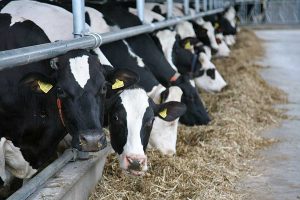News 028
News

European Milk Board / 09 July 2021
Latest milk production cost study shows hefty expenses, but only low or no income for farmers across the EU
Press release / (Brussels/B) A succinct and highly-informative document has been made available to European milk producers today. The latest study entitled What is the cost of producing milk? presents the situation on EU dairy farms in the form of clear and reliable figures.
In addition to the milk production costs in eight key milk-producing countries, this latest version of the cost study also includes an EU average for the very first time. In 2019, the average cost was 45.35 cents/kg, and with EU prices averaging 34.52 cents/kg, there was a significant cost shortfall. “This clearly shows a problematic imbalance throughout the EU,” explains Sieta van Keimpema, President of the European Milk Board (EMB) from the Netherlands.
Another novel feature: With Ireland and Lithuania, the study by the Bureau for Rural Sociology and Agriculture (BAL) includes two new countries that are at opposite ends of the cost spectrum. With its unique production system, Ireland with 34.21 cents/kg had the lowest production costs in 2019 by a long shot. However, the tendency of cost shortfalls is seen here as well, as costs have increased significantly in the period included in the study, but prices have not evolved accordingly. As a result, costs were not covered in three of the five years included in the study, even in this country with extremely favourable conditions for milk production. Lithuania, with its differentiated farm structure and many small farms, easily tops the list with the highest production costs (58.63 cents/kg). Together with an extremely low milk price of 28.79 cents/kg, the producers in this Baltic country are struggling with an enormous cost shortfall of 51 per cent.
When looking at all the countries together, it is interesting to see that production costs span a broad range between about 34 cents/kg and 59 cents/kg. But when it comes to prices, the disparity shrinks significantly from almost 29 cents/kg to just above 34 cents/kg.
Critical income situation
A look at two large milk-producing countries – Netherlands and Denmark – shows that once costs have been deducted, farm managers and family labour are left with absolutely nothing in hand and thus no income. “We have to bear in mind that we are talking about the Netherlands and Denmark – countries with very modern farms that continue to take on new technical developments. But in spite of this, those running dairy farms are not left with a single penny in hand,” says Sieta van Keimpema, pointing to this very difficult situation.
Income is at a very critical level in other countries as well. Only Ireland manages to get somewhere close to what has been calculated as appropriate income. Dr. Karin Jürgens, the author of the study, summarises as follows: “Dairy farms are not just missing the earnings needed for stable and future-proof operations. They are not even making enough for an appropriate income or even an adequate living.” To the potential criticism that income values are set too high, she responds to the contrary: “The income variable in the study considers the level of training and qualifications and is objectively based on applicable agricultural collective agreements or twice the national minimum wage in the country in question.” Kjartan Poulsen, EMB Vice-President and organic dairy farmer in Denmark, goes on to add: “How can it be acceptable for someone to earn nothing or close to nothing? We are a well-trained workforce with long-standing experience, and we work hard every day. That includes weekends and holidays. Especially during the pandemic, farmers left no stone unturned to ensure that there was never an issue with food supplies. Furthermore, we also undertake major risks and shoulder significant responsibility for our animals, for food security and for the environment.”
As French dairy farmer and EMB Executive Committee member Boris Gondouin explains, the brochure offers a good basis for confident campaigning and progress toward appropriate prices: “I am very happy to have this new brochure with a very clear structure in hand, especially because it is a tool that is based on reliable, founded data. It allows me as a dairy farmer to comprehensively understand cost developments. And not just in my country.” He has a recommendation for all dairy farmers: “Take this proof of production costs with you to every meeting with dairies, retailers and policy-makers and use it to demand fair prices!” EMB President van Keimpema also adds: “The next generation, the future of food production, would also like to produce milk. Let’s use this study and, once again, make this viable for them!”
For the author Dr Jürgens, these figures also provide important insights for successful implementation of current environmental policies like the Green Deal: “Farms will only be in a position to contribute to the implementation of environmental, climate and animal welfare goals that imply higher costs if there are lasting improvements to their economic situation.”
Summary of key figures:
In 2019, milk production costs including appropriate remuneration were lower than paid milk prices in all eight countries and in the EU on average – and this is without any consideration of average net investments. Costs were between 34.21 cents/kg in Ireland and 58.63 cents/kg in Lithuania, with 45.35 cents/kg as the EU average. This implies a cost shortfall of 9% (Ireland) all the way up to 51% (Lithuania), and 24% across the EU.
further information: European Milck Board (EMB), www.europeanmilkboard.org